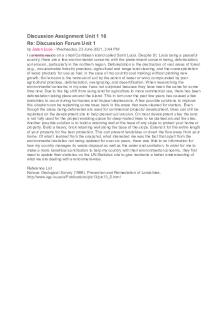CS1101 Discussion Assignment Unit 1 PDF

| Title | CS1101 Discussion Assignment Unit 1 |
|---|---|
| Course | Programming Fundamentals |
| Institution | University of the People |
| Pages | 2 |
| File Size | 73.1 KB |
| File Type | |
| Total Downloads | 212 |
| Total Views | 561 |
Summary
Type the statements below into your Python interpreter. For each statement , copy the output into your Discussion Assignment and explain the output. Compare it with any similar examples in the textbook, and describe what it means about your version of Python.>>> print 'Hello, Wo...
Description
Type the statements below into your Python interpreter. For each statement, copy the output into your Discussion Assignment and explain the output. Compare it with any similar examples in the textbook, and describe what it means about your version of Python. >>> print 'Hello, World!' >>> 1/2 >>> type(1/2) >>> print(01) >>> 1/(2/3)
>>> print 'Hello, World!' SyntaxError: Missing parentheses in call to 'print'. Did you mean print('Hello, World!')?
Here, the output displays a syntax error for missing parentheses. I am using Python 3 where the parentheses indicate that print is a function. In Python 2, the print statement is slightly different; it is not a function, so it doesn’t use parentheses. In section 1.3 of the textbook, there's a similar example. >>> 1/2 0.5
Python provides operators. The operator / performs division. A similar example is in section 1.4 of the textbook. >>> type(1/2)
A similar example is in section 1.5 of the textbook. In this result, the word “class” is used in the sense of a category; a type is a category of values. Integers belong to the type int, strings belong to str and floating-point numbers belong to float. From the previous statement, we saw the output is a floating-point number; so it belongs to the float class. >>> print(01) SyntaxError: leading zeros in decimal integer literals are not permitted; use an 0o prefix for octal integers
In math notation, leading zeros are ok, as in 02. But in Python, it displays syntax error. As it's stated in the output, leading zeros in decimal integer literals are not permitted in Python. There's a similar exercise in the Chapter 1 exercise 1.1 section of the textbook. >>> 1/(2/3) 1.5
Python follows arithmetic formulas and conventions usually. So, using brackets and division operators between numbers in this statement, after mathematic computation, the output is a floating-point number....
Similar Free PDFs

Discussion Assignment Unit 1 16
- 1 Pages

CS1101 Unit 6 Quiz
- 5 Pages

Discussion Assignment Unit 5
- 2 Pages

Discussion assignment Unit 2
- 2 Pages

Discussion Assignment Unit 4
- 1 Pages

Discussion Assignment Unit 4
- 3 Pages

Discussion Assignment Unit 2
- 2 Pages

CS1101 Unit 5 Quiz
- 3 Pages

Discussion assignment unit 6
- 2 Pages

Discussion Assignment Unit 4
- 2 Pages

CS1101 Unit 7 Quiz
- 5 Pages

CS1101 Unit 8 Quiz
- 8 Pages

Cs1101 learning jurnal unit 4
- 2 Pages
Popular Institutions
- Tinajero National High School - Annex
- Politeknik Caltex Riau
- Yokohama City University
- SGT University
- University of Al-Qadisiyah
- Divine Word College of Vigan
- Techniek College Rotterdam
- Universidade de Santiago
- Universiti Teknologi MARA Cawangan Johor Kampus Pasir Gudang
- Poltekkes Kemenkes Yogyakarta
- Baguio City National High School
- Colegio san marcos
- preparatoria uno
- Centro de Bachillerato Tecnológico Industrial y de Servicios No. 107
- Dalian Maritime University
- Quang Trung Secondary School
- Colegio Tecnológico en Informática
- Corporación Regional de Educación Superior
- Grupo CEDVA
- Dar Al Uloom University
- Centro de Estudios Preuniversitarios de la Universidad Nacional de Ingeniería
- 上智大学
- Aakash International School, Nuna Majara
- San Felipe Neri Catholic School
- Kang Chiao International School - New Taipei City
- Misamis Occidental National High School
- Institución Educativa Escuela Normal Juan Ladrilleros
- Kolehiyo ng Pantukan
- Batanes State College
- Instituto Continental
- Sekolah Menengah Kejuruan Kesehatan Kaltara (Tarakan)
- Colegio de La Inmaculada Concepcion - Cebu


